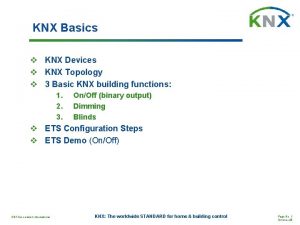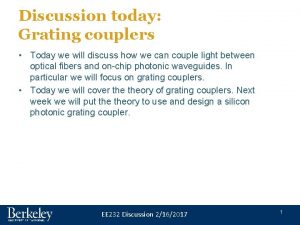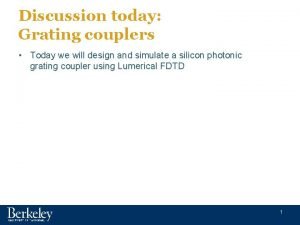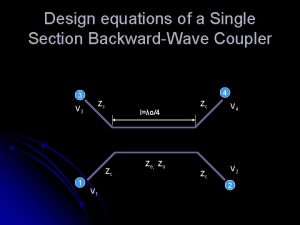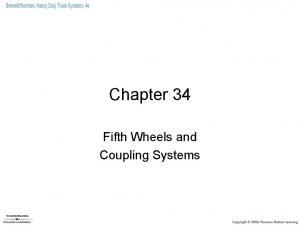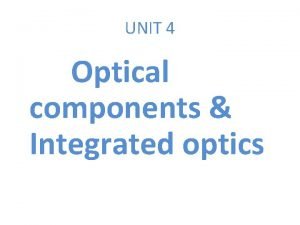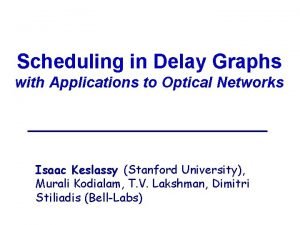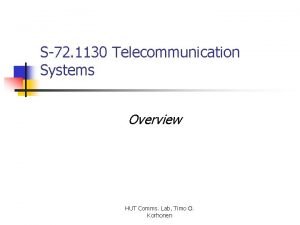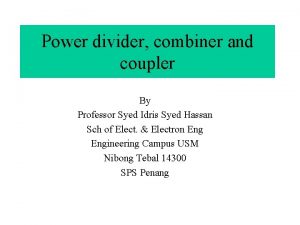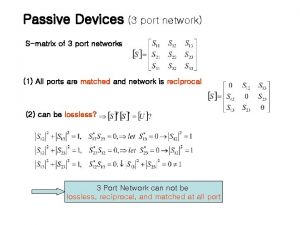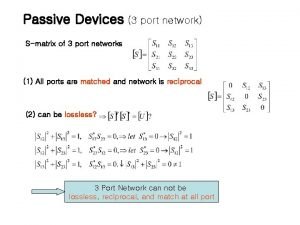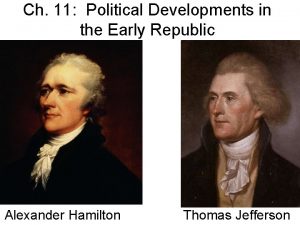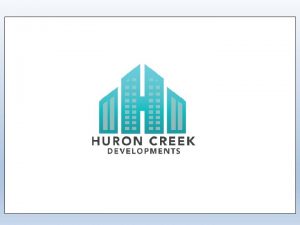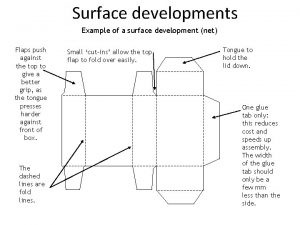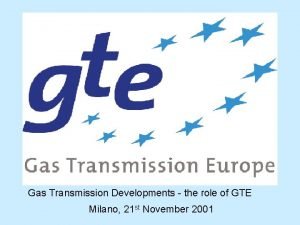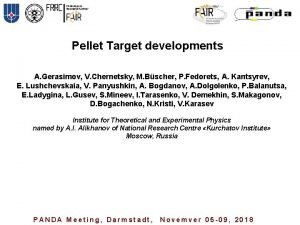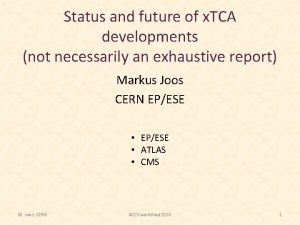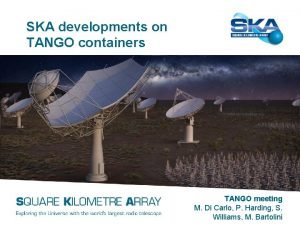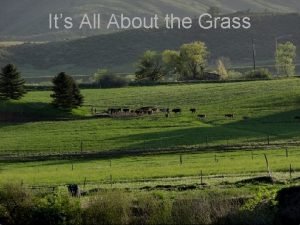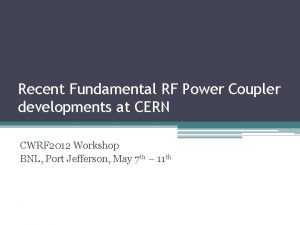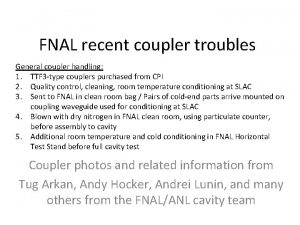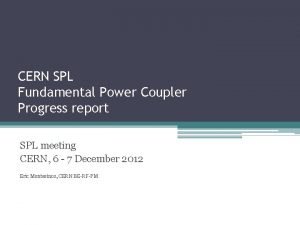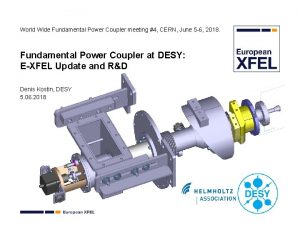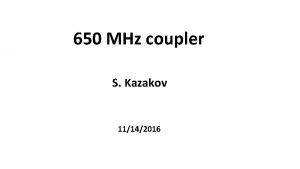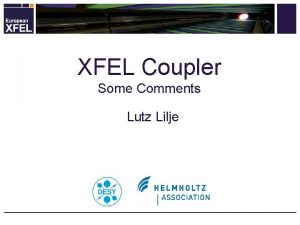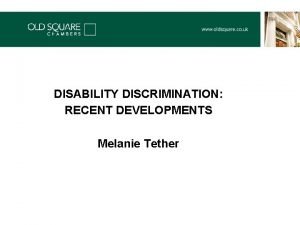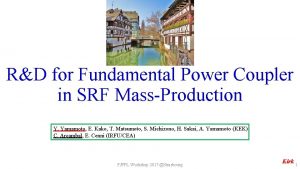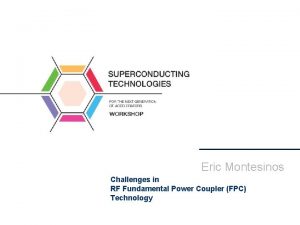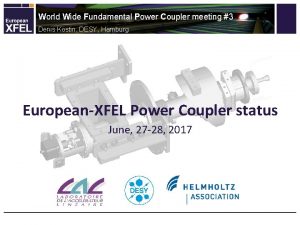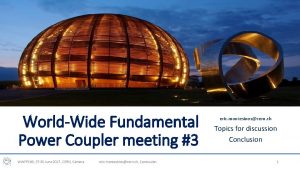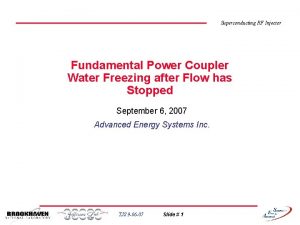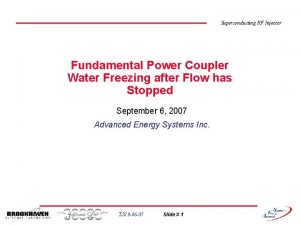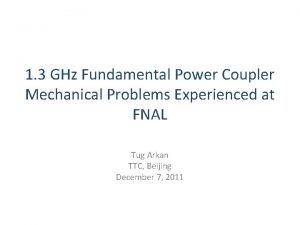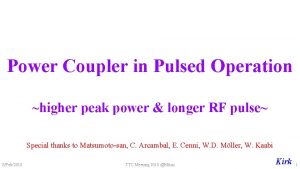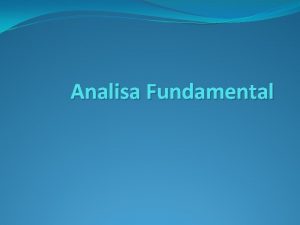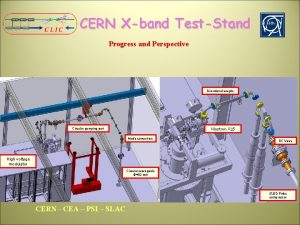Recent Fundamental RF Power Coupler developments at CERN


































- Slides: 34

Recent Fundamental RF Power Coupler developments at CERN First SLHi. PP meeting CERN, Geneva, 8 & 9 December 2011

2 Acknowledgements • SPL coupler review committee : ▫ Ali Nassiri, Wolf Dietrich Moeller, Mark Champion, Sergey Kazakov, Mircea Stirbet, Amos Dexter, Rama Calaga, Miguel Jimenez, Sergio Calatroni, Ofelia Capatina, Vittorio Parma • DESY : ▫ Wolf-dietrich Moeller, Axel Matthaisen, Birte Van der Horst, and team • CEA : ▫ Stephane Chel, Guillaume Devanz, Michel Desmond, and team • ESRF : ▫ Jorn Jacob, Vincent Serriere, Jean. Maurice Mercier, Didier Boilot, and team • APS : ▫ Ali Nassiri, Doug Horan, Gian Tenko, Dave Brubenker, and team First SLHi. PP meeting, 8 & 9 December 2011 • CERN : ▫ Mechanical & Material Engineering group : � Ramon Folch, Francesco Bertinelli, Serge Mathot, Agostino Vacca, Thierry Tardy, Thierry Calamand, Thierry Renaglia, Ofelia Capatina, Marc Polini, Laurent Deparis, Philippe Frichot, Jean-Marie Geisser, Jean. Marc Malzacker, Pierre Moyret, Alain Stadler, and team ▫ Vacuum, Surface & Coating group : � Miguel Jimenez, Sergio Calatroni, Wilhelmus Vollenberg, Marina Malabaila, Nicolas Zelko, and team ▫ Magnets, Superconductors & Cryostats group: � Vittorio Parma, Arnaud Van de Craene, and team ▫ RF group : � Sebastien Calvo, Antoine Boucherie, Nicolas Jurado, Charles Julie, all FSUAB 03 team members Eric Montesinos

3 Contents • SPL couplers • ESRF/SOLEIL/APS couplers • Linac 4 window First SLHi. PP meeting, 8 & 9 December 2011 Eric Montesinos

4 SPL coupler requirements Technical Choices RF Characteristics Single window coupler f 0 704. 4 MHz With a Double Walled Tube Power levels Mounted in clean room with its double walled tube horizontally in only one operation 1000 k. W pulsed 0. 4 + 1. 2 + 0. 4 = 2. 0 ms 50 Hz (20 ms) 100 k. W average Cavity design gradient 19 -25 MV/m Qext of input coupler 1. 2 x 106 Fixed coupler Vertically below the cavity and will be a support for the cavity (first time worldwide) With a HV DC biasing capacitor Air cooled First SLHi. PP meeting, 8 & 9 December 2011 Input line Ø Waveguides 100 / 43. 5 mm = 50 Ω (from the cavity design) WR 1150 Eric Montesinos

5 Two proposed designs First SLHi. PP meeting, 8 & 9 December 2011 Eric Montesinos

6 SPL coupler project • Four ‘vacuum lines’: ▫ 4 cylindrical window couplers ▫ 4 planar disk window couplers ▫ 8 Double walled Tubes ▫ 4 test boxes • DESY clean process assembly ▫ (Jlab also proposed to help) • CERN LLRF measurements • CEA RF power tests ▫ (BNL also proposed to help) First SLHi. PP meeting, 8 & 9 December 2011 Eric Montesinos

7 Couplers construction • All components have been constructed by May 2011 ▫ ▫ 4 cylindrical window couplers 4 planar disk window couplers 8 Double walled Tubes 4 test boxes • All components have been individually vacuum leak free tested • Specific transport boxes with springs as per tetrodes have been designed to avoid any shocks First SLHi. PP meeting, 8 & 9 December 2011 Eric Montesinos

8 Test box • Test box is made with only two parts with a helicoflex seal : ▫ Upper cover with included machined vacuum knife flanges included ▫ Two covers with inner copper plated • Advantages : ▫ Easier (not easy) to copper plate ▫ Easily cleanable regarding clean room requirements for high gradient field cavity ▫ Can be used for several sets of couplers (if large series : SPL, …) • Drawbacks : ▫ Helicoflex faces have to be very well prepared ▫ Self-supporting structure : heavy weight First SLHi. PP meeting, 8 & 9 December 2011 • Holes for vacuum port : ▫ without sharp edges ▫ L = 5 x D to allow correct RF shielding (P peak max = 1’ 000 k. W !), helped with additional vacuum tombac Eric Montesinos

9 Waveguides • Six parts waveguide • Easy mounting • Easily exchangeable shims and allows post machining of internal step for matching if needed • Knife contacts all along to suppress any gap at intersections in order to avoid any arcing (DESY difficulties with brazed WG) • No mechanical stress given to the ceramic, fixed point onto the body only • Capacitor self centered around the ceramic and designed to symmetrically air cool the ceramic First SLHi. PP meeting, 8 & 9 December 2011 Eric Montesinos

10 Planar disk inner line • As the coupler must be air cooled to avoid any water leak 1 MW RF contact • Specific trick to ensure inner RF contact : ▫ Inner line on top of the ▫ ▫ ▫ ceramic Springs are compressed Air cane inside the inner line Screw to the inner ceramic Release springs to ensure RF contacts Absolutely no stress to the ceramic First SLHi. PP meeting, 8 & 9 December 2011 Eric Montesinos

11 Clean room assembly (DESY) • Test box assembly not easy because of specific surfaces roughness needed for helicoflex • Couplers assembly was also not easy because : ▫ Couplers are heavy ▫ Last connection has to be done manually ▫ Ok for few prototypes, not for a large series • Two cavities were sent to CERN, but… First SLHi. PP meeting, 8 & 9 December 2011 Eric Montesinos

12 Double walled Tube (DT) • Despite a previous long experience with LEP and LHC DT, a difficulty occurred in the construction process : ▫ An additional machining has erased all the care put into the preparation of DT • Copper sputtering was removed with a simple water Ultra Sonic cleaning process • Decision to condition the two first vacuum lines with NOT copper coated DT First SLHi. PP meeting, 8 & 9 December 2011 Eric Montesinos

13 Low Power measurements (CERN) • S 11 with 2 x N/WG adaptors + 2 couplers + 2 DT + test box : ▫ Cylindrical = -26. 5 d. B ▫ Planar disk = -18 d. B • Even with -16 d. B, 1 MW corresponds to 25 k. W reverse power • Ok for first tests First SLHi. PP meeting, 8 & 9 December 2011 Eric Montesinos

14 RF tests (CEA premises) • Tests started with cylindrical window couplers • Not baked out, static vacuum ~ 2 x 10 -7 mbar ▫ Wanted to check RF ▫ Size of the test box 250 mm x 600 mm ▫ Helicoflex • Pulse mode process • After 3 weeks, 50 k. W 20 us / 20 Hz • We stopped the test First SLHi. PP meeting, 8 & 9 December 2011 Eric Montesinos

15 RF tests • In the meantime, second test box with two planar disk window coupler has been baked out • No helicoflex leak ▫ Very slow heating up and heating down ramps 10 C / hour ▫ Maximum temperature was only 150 C during three days ▫ Nitrogen onto copper rings to avoid any oxidization • Very good static vacuum after the process: ▫ ~ 1 x 10 -9 mbar ▫ Was 2 x 10 -5 mbar before starting the bake out First SLHi. PP meeting, 8 & 9 December 2011 Eric Montesinos

16 RF tests • Restarted the tests with the planar disk window couplers • Pulse mode process starting with 20 µs pulses / 8 Hz • After 10 days : 1000 k. W 2 ms / 8 Hz First SLHi. PP meeting, 8 & 9 December 2011 Eric Montesinos

17 RF tests • Still some out gazing around three power levels : ▫ 20 k. W ▫ 140 k. W ▫ 300 k. W • No more vacuum activity above 300 k. W • Processing around these values is under way and vacuum decreases ramp after ramp • Tests ongoing to reach 1000 k. W 2 ms / 50 Hz (uncoated DT limitation) First SLHi. PP meeting, 8 & 9 December 2011 Eric Montesinos

18 Next steps • While testing the planar disk window couplers, we baked out cylindrical couplers (already seen RF) : ▫ Initial static vacuum ~ 1. 0 x 10 -6 mbar ▫ After bake out, static vacuum ~ 1 x 10 -10 mbar • Once planar disk window coupler tests finished, restart cylindrical window coupler tests • These tests are scheduled beginning 2012 First SLHi. PP meeting, 8 & 9 December 2011 • Corrected DT copper coating under way • Cryostat flanges to be added prior to new clean room assembly • Mounting of chosen design at DESY clean room: ▫ Two tests cavities ▫ Four copper coated DT with cryostat flanges ▫ Four couplers • RF tests at Saclay premises of the four chosen couplers Eric Montesinos

19 Key RF items • Ceramic and waveguide as a whole matching system • Waveguides: ▫ ‘Plug and Play’ ▫ No doorknob ▫ Reduced height ▫ Screwed waveguide ▫ No mechanical stress to the ceramic First SLHi. PP meeting, 8 & 9 December 2011 • Test cavity in two parts, easier to copper plate and easy to clean • Inner line of planar disk window with RF contacts ensured by compression of springs • Only air cooled couplers Eric Montesinos

20 ESRF/SOLEIL/APS coupler requirements RF Characteristics f 0 352. 2 MHz Power levels 200 k. W cw Technical choices Single window, fixed coupler Waveguides WR 2300 half height Mechanical constraints Must match with previous design without any infrastructure modification First SLHi. PP meeting, 8 & 9 December 2011 Eric Montesinos

21 Kovar vs copper window • LEP Kovar® brazed window : ▫ Kovar ® rings on both ends ▫ Body and Antenna with Stainless Steel rings brazed onto copper ▫ TIG welding under mechanical pressure ensuring RF contact ▫ Easy Kovar ® brazing process ▫ Weakness of the design : RF contact ▫ High field between two Kovar ® ‘antennas’, arcing • LHC copper brazed window : ▫ Massive copper ring for high power ▫ No RF contact, fully continuous RF path ▫ Spherical ends of copper rings for no arcing ▫ Very difficult brazing process (6 years to be finalized) ▫ Advantage of the design: extremely powerful First SLHi. PP meeting, 8 & 9 December 2011 Ceramic LEP kovar collar RF contact via compression while TIG welding Ceramic LHC copper collars EB welded Metallic continuity Eric Montesinos

22 Kovar vs copper window • APS coupler with kovar/copper misalignment : ▫ ▫ RF contact lost kovar has metalized ceramic (grey) Thermal losses Vacuum leak • CERN Kovar vs CERN copper with a LHC test : ▫ kovar RF losses ▫ Thermal overheating ▫ Burnt kapton and peek (> 250 C) • Copper ceramic window is not only a simple upgrade, it is a very new design really stronger than kovar window ceramic First SLHi. PP meeting, 8 & 9 December 2011 Eric Montesinos

23 ESRF coupler project • LEP I style coupler became ESRF trouble maker (five unexplained vacuum leaks in 2008) • Proposal of a new coupler to fit into existing premises with NO infrastructure modification • Coupling loop : ▫ Water cool to be sure there will be no mechanical stress given to the ceramic • Three vacuum ports for conditioning process: ▫ ▫ ▫ Vacuum gauge close to the ceramic Glass window for arc detection e- antenna • First prototype delivered September 2011 First SLHi. PP meeting, 8 & 9 December 2011 Eric Montesinos

24 ESRF coupler tests • Bake out onto cavity process • CERN pulsed mode conditioning process under vacuum feedback • Off tune, 200 k. W pulsed 5 ms / 50 Hz in 22 hours • On tune, 200 k. W cw in 60 hours • Qualified for ESRF needs • Last week, on tune 300 k. W cw First SLHi. PP meeting, 8 & 9 December 2011 Eric Montesinos

25 ESRF/SOLEIL next steps • Further tests to higher power levels, up to maximum test bench capability, i. e. 350 k. W cw • Two additional ESRF ‘series couplers’ • Two SOLEIL couplers: ▫ Electrical antenna, air cooled ▫ CERN LEP type test cavity ▫ Outer coaxial line with corrected length ▫ Tests at ESRF First SLHi. PP meeting, 8 & 9 December 2011 Eric Montesinos

26 APS coupler project • Collaboration requested during CWRF workshop Barcelona in April 2010 • Present coupler also LEP I type limited to 100 k. W cw • Design similar to ESRF: ▫ Coupling loop differs ▫ Inches vs mm ▫ Waveguide air cooling as personal safety interlock • Individual bake out of the coupler, reduced exposition to air (not under mobile clean room) First SLHi. PP meeting, 8 & 9 December 2011 Eric Montesinos

27 APS ‘picture horizontal flip’ • Loop angle does not allow any vacuum ports to be useful • Not needed because cavity is small enough, pumping perfect (1 x 10 -9 Torr without RF) • If one additional coupler, it will be with no more vacuum ports: ▫ Reduces the costs to its minimum ▫ Reduces the risk of vacuum potential leaks ▫ Cavity small enough to ensure a correct vacuum monitoring First SLHi. PP meeting, 8 & 9 December 2011 Eric Montesinos

28 APS coupler tests and next steps • Tests started last week • Conditioning in cw mode with a very low pressure: Vacuum Power ▫ 1 x 10 -8 Torr maximum ▫ interlock at 5 x 10 -8 Torr • 25 k. W cw after two days • Further tests to higher power levels, up to maximum test bench capability, i. e. 200 k. W cw • Implementation of CERN pulse mode conditioning system First SLHi. PP meeting, 8 & 9 December 2011 Eric Montesinos

29 Linac 4 window requirements RF Characteristics f 0 352. 2 MHz Power levels 1250 k. W pulsed 2 ms / 50 Hz (SPL cycle) Waveguides WR 2300 Mechanical constraints As short as possible First SLHi. PP meeting, 8 & 9 December 2011 Eric Montesinos

30 Ceramic assembly • As simple as possible : ▫ 1 : Ceramic Ø 400 mm x 25 mm ▫ 2 : Inner copper ring Ø 400 mm x 1. 25 mm ▫ Outer copper ring ▫ Stainless steel ring for Helicoflex • Two first individually brazed subassemblies: ▫ Brazed ceramic = ceramic + inner copper ring ▫ Outer ring for Vacuum seal = outer copper ring + stainless steel ring • Main ceramic = EB welding of two parts • Ti sputtering of the vacuum side First SLHi. PP meeting, 8 & 9 December 2011 Eric Montesinos

31 LINAC 4 window project • As simple as possible ▫ 1 -2 -3 -4 : Ceramic assembly ▫ 5 : spacer ▫ 6 : Helicoflex seal ▫ 7 -8 : Stainless Steel flanges • Massive flanges, not copper plated • More difficult design than it look likes because of the two shapes : cylindrical and rectangular, with incorporated screws First SLHi. PP meeting, 8 & 9 December 2011 Eric Montesinos

32 LINAC 4 window next step • First prototype with helicoflex ▫ Low Power RF ok • Second prototype with no helicoflex but an Electron Beam Welding is under construction • Tests of two prototypes face to face onto a vacuum waveguide line in CEA premises : ▫ 1. 25 MW 2 ms 50 Hz ▫ Define the best design (Helicoflex/EBW) • Series construction of 30 windows ▫ Ceramics already ordered First SLHi. PP meeting, 8 & 9 December 2011 Eric Montesinos

33 Future coupler developments • HIE-Isolde, under way ▫ ▫ 100 MHz 500 W (1 k. W ? ) Operating at 2 k Inside vacuum vessel • LIU-SPS 200 MHz ▫ New concept with coaxial plain disk and capacitive coupling ▫ 900 k. W pulsed 50 % (ms) ▫ 450 k. W cw power • SPS 800 MHz consolidation ▫ Scaling of Linac 4 to 800 MHz ▫ 150 k. W cw First SLHi. PP meeting, 8 & 9 December 2011 • One for all Crab Cavities coupler ▫ Same window for all cavities ▫ Compatible with various coupling system • Whatever new coupler needed Eric Montesinos

34 Thank you very much for your attention And many thanks again to all the persons involved in all these projects First SLHi. PP meeting, 8 & 9 December 2011 Eric Montesinos
 Recent developments in ict
Recent developments in ict Recent developments in object detection
Recent developments in object detection Graphical linkage synthesis
Graphical linkage synthesis Hva er knx
Hva er knx Grating coupler
Grating coupler Grating coupler lumerical
Grating coupler lumerical Backward wave coupler
Backward wave coupler Compensating fifth wheel
Compensating fifth wheel Distributive coupler are also called as
Distributive coupler are also called as Star coupler
Star coupler Telecom huts
Telecom huts Coupled line coupler
Coupled line coupler 3 port network
3 port network Coupled line coupler
Coupled line coupler Power traiangle
Power traiangle Sahelanthropus tchadensis cultural development brainly
Sahelanthropus tchadensis cultural development brainly Peter rosenwald
Peter rosenwald Political developments in the early republic
Political developments in the early republic Huron creek
Huron creek Chapter 11 political developments in the early republic
Chapter 11 political developments in the early republic Netflaps
Netflaps Gte milano
Gte milano In the colonial era developments such as the new england
In the colonial era developments such as the new england Target developments
Target developments Pattern development meaning
Pattern development meaning Pattern of development
Pattern of development Tca developments
Tca developments Democratic developments in england
Democratic developments in england Cplim
Cplim Surface developments
Surface developments Mdi medical devices international
Mdi medical devices international Donmeg developments
Donmeg developments Democratic developments in england
Democratic developments in england Five fundamental
Five fundamental Recent trends in ic engine
Recent trends in ic engine



